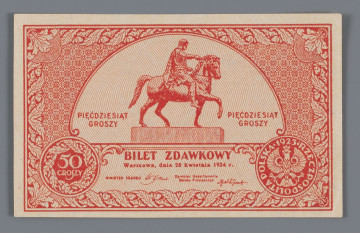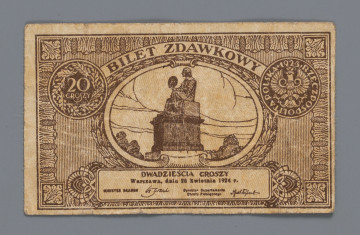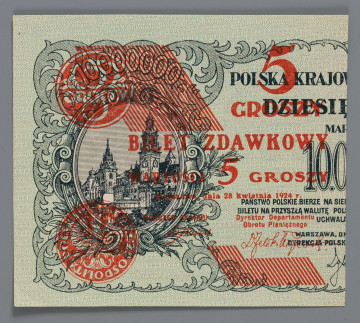
50 groshes [Polish: grosze]
1924
National Museum in Lublin
Part of the collection: Paper money during the Second Polish Republic
The implementation of the currency-related reforms of Władysław Grabski's Government meant the withdrawal of the Polish mark from circulation, with the simultaneous introduction of the zloty. Initially, the Government's actions were aimed at calming down the unstable market through an extensive budget-savings policy. Only later was it decided to introduce the new currency into circulation. According to the original assumptions, lower denominations were to be issued in the form of coins. However, the inability to produce a sufficient number of coins forced the authorities to introduce tickets in its place. In the case of one- and five-groszy denominations, a temporary solution was used in the form of re-using halves of 500,000 and 10,000,000 Polish mark banknotes that had been withdrawn from circulation. The 10-, 20- and 50-grosz tickets were given a specially prepared graphic design. In the case of the ten-groszy tickets it was blue and on the obverse in the central field it depicted the Sigismund column against the background of a fragment of the Royal Castle in Warsaw. On both sides, there were images of the obverse and the reverse of the ten-groszy coin, which the ticket temporarily replaced. On the reverse there was only the text of a legal clause printed in brown. Unfortunately, the author of the design is unknown.
None of pass tickets were very well-protected against forgery. In fact, the only protection was a watermark in the form of a regular braid of stripes. The tickets also lacked series and numbering. Their printing was commissioned to the State Graphic Works in Warsaw. A total of 27,144,000 pieces were printed during the issue period. In contrast to banknotes issued by the issuing bank, i.e., initially the Polish National Loan Fund, later Bank of Poland, the issuer of the pass tickets was directly the Treasury. They were introduced into circulation on 5 May 1924, although the date of 28 April of that year was printed on the tickets. Their circulation period was therefore relatively short. The process of collecting the ten-groszy tickets from the market, similarly to other pass tickets, started, according to the clause printed on the reverse, on 1 November 1924, and the exchange lasted until 31 January 1925. Unfortunately, this did not mean the end of the circulation of temporary money on the Polish market.
Leszek Poniewozik
Author / creator
Dimensions
cały obiekt: height: 70 mm, width: 42 mm
Object type
paper money
Technique
Material
paper
Creation time / dating
Creation / finding place
Owner
The National Museum in Lublin
Identification number
Location / status

1924
National Museum in Lublin

1924
National Museum in Lublin

1924
National Museum in Lublin
DISCOVER this TOPIC
Castle Museum in Łańcut
DISCOVER this PATH
Educational path